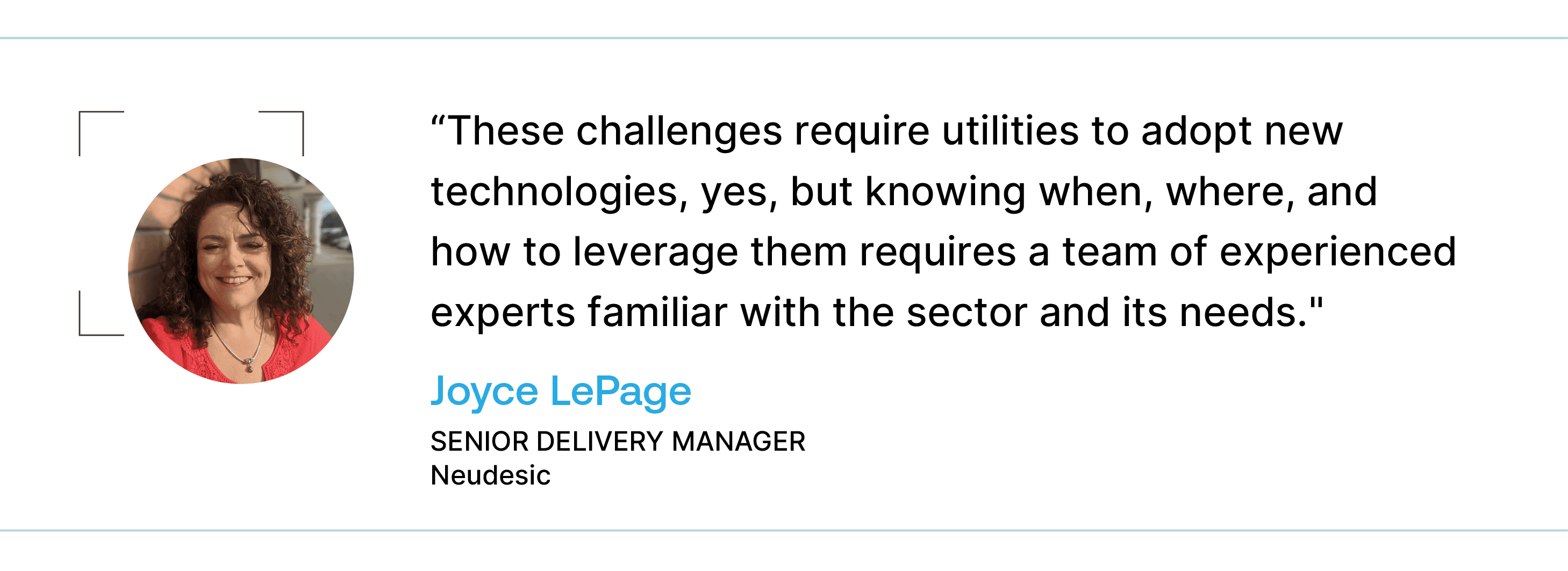
As the utilities sector deals with aging infrastructure and unprecedented demand, integrating Artificial Intelligence (AI) and Generative AI (GenAI) into operations, customer experience, and sustainability offers significant opportunities. Bringing it to reality, however, requires professionals with a mix of competencies in software development and experience within the heavily regulated industry.

Joyce LePage is one of these professionals. A seasoned expert in the industry, she has spent the last 25 years identifying and implementing innovative technology at one of the United States’ biggest utilities. From customer service and outage management to IT and enterprise data solutions, she’s now lending her experiences and insights to Neudesic clients.
“These challenges require utilities to adopt new technologies, yes, but knowing when, where, and how to leverage them requires a team of experienced experts familiar with the sector and its needs,” says Joyce.
We sat down with her to discuss the potential of GenAI and the fundamental shift it will create for how utilities operate and interact with their customers and the environment.
Enhancing Customer Engagement and Satisfaction
Through a combination of personalization, self-service, and predictive engagement, “GenAI has the power to revolutionize customer engagement in the utilities sector, elevating service to levels comparable with consumer-driven sectors like retail and entertainment,” Joyce asserts.
The power of personalization: Personalization is key to enhancing customer engagement in today’s world. According to Joyce, customers have grown to expect similar service levels around on-demand capabilities, reliability, and customer support to be similar to that of companies like Amazon or Netflix. These expectations have spilled over into various interactions with other non-retail services, like utilities. While lofty, meeting these expectations builds immediate trust and loyalty.
She recommends investing in personalized communications. “Customers want to know how they can lower their specific energy consumption and costs, as well as prevent interruptions in service,” stating, “Personalized communications’ that are more frequent (but not too frequent!), accurate, timely, and actionable work best,” she notes.
Joyce mentioned one example where customers are notified that their on-file credit card is about to expire, allowing them to update their information and avoid missed payments. Alternatively, using a payment provider’s card updater service can automatically replace an expired card with a new one. While sending a notification might seem redundant, Joyce notes it serves as an excellent reminder of how your utility prioritizes customer care.
Self-service options: Reflecting on the digital transformation in consumer services, Joyce highlights the need for robust self-service capabilities in the digital channel of choice, “be it mobile, online or kiosk.” This approach empowers customers by giving them the tools to manage their services independently, enhancing their overall satisfaction and engagement. She suggests implementing intuitive platforms that allow customers to easily access their accounts, view their consumption data in real-time, and manage service settings or report issues without needing direct human interaction.
Proactive customer engagement: Joyce envisions a future where utilities proactively engage with customers leveraging all available digital channels. “By anticipating needs and solving problems before they escalate, we improve customer satisfaction and strengthen relationships with our community,” she notes. Utilizing predictive analytics, utilities can foresee and address service disruptions, recommend custom solutions for energy efficiency, and even adjust billing plans to better suit customer usage patterns automatically.
“By focusing on the customer’s needs and preferences, we can drive a significant shift in how utilities interact with their customers,” Joyce concludes.
Driving sustainability and resilience
Utility companies must navigate an increasingly complex regulatory and technological landscape; however, there are opportunities to mitigate these impacts by leveraging cutting-edge technology and innovative strategies to meet these challenges effectively.
Innovative resource and asset management: Joyce highlights the potential application of GenAI in predictive maintenance and grid optimization. By anticipating maintenance needs and optimizing energy distribution based on real-time data, utilities can significantly reduce energy waste and extend the lifespan of their infrastructure.
“GenAI has the potential to unlock this massive untapped value in data, which, when utilized, transforms how we manage and operate our grids,” she notes. This proactive management not only conserves resources but also reduces the carbon footprint of operations.
Collaborative regulatory engagement: Joyce believes, when used responsibly, AI can deepen engagement with regulatory bodies to foster an environment that supports innovation. Perhaps more than any use case, she flags general rate cases as one of the bigger opportunities for utilities when it comes to AI. “Not only can we streamline the capture and analysis of data using products, like Databricks Intelligence Platform for Energy, but we embed AI in our systems and train it to craft comprehensive and meaningful, high-impact submissions more swiftly than ever before.”
Some problems, Joyce noted, aren’t solved with technology alone, but require work and collaboration with certain external organizations. “Working with regulators to ensure they are prepared to recognize and support new and innovative technologies is crucial,” she said.
Proactive resource allocation: Focusing on resilience, Joyce discussed how GenAI could easily support utilities in becoming more agile and proactive. By predicting peak loads and potential system stresses, utilities can allocate resources more effectively, preventing overloads and minimizing service disruptions during extreme conditions. This capability is critical for adapting to the increasing frequency of extreme weather events.
AI at utilities is here to stay
As we wrapped up, Joyce noted that leaders must think holistically about the strategic value of GenAI-not just as one-off projects, but as an integral component of their operations moving forward. When planning future operations and investments, from field safety to tree removal to general rate case workflows, the potential value of AI should be a primary consideration.
Interested in accelerating your utility’s AI strategy or implementation and working with experts, like Joyce? Explore the services and capabilities or contact Microsoft’s finalist for Partner of the Year in Energy and Resources.
Related Posts